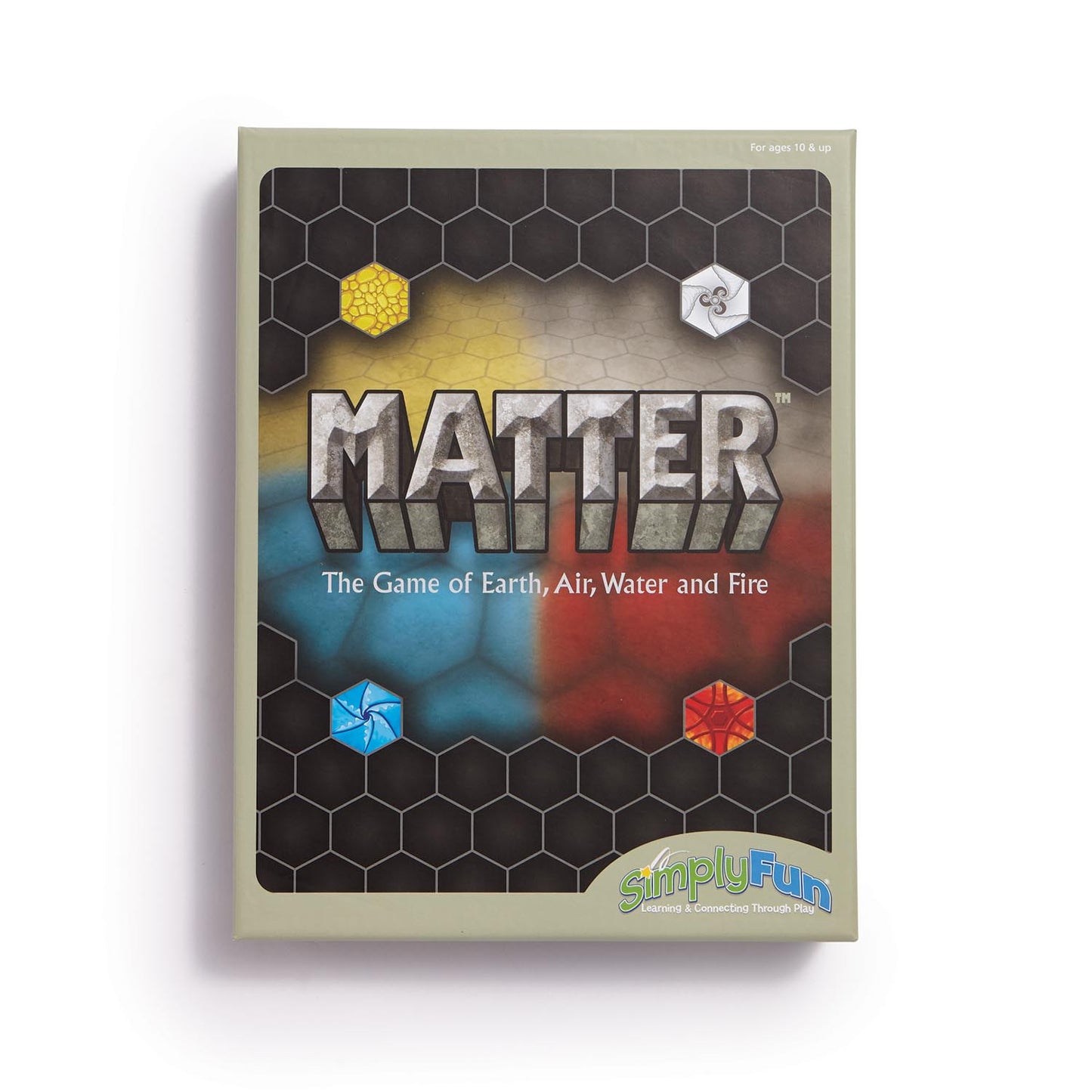
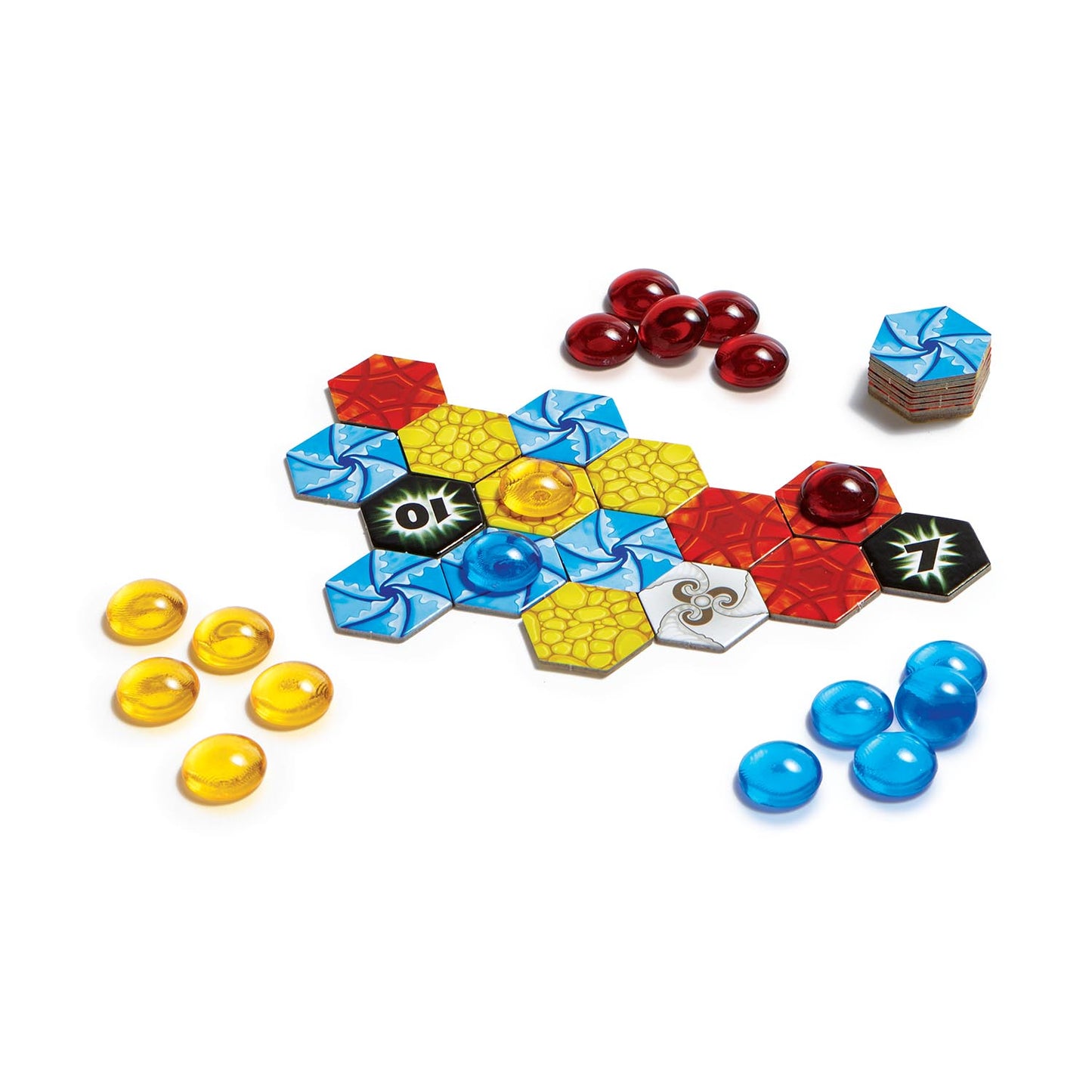
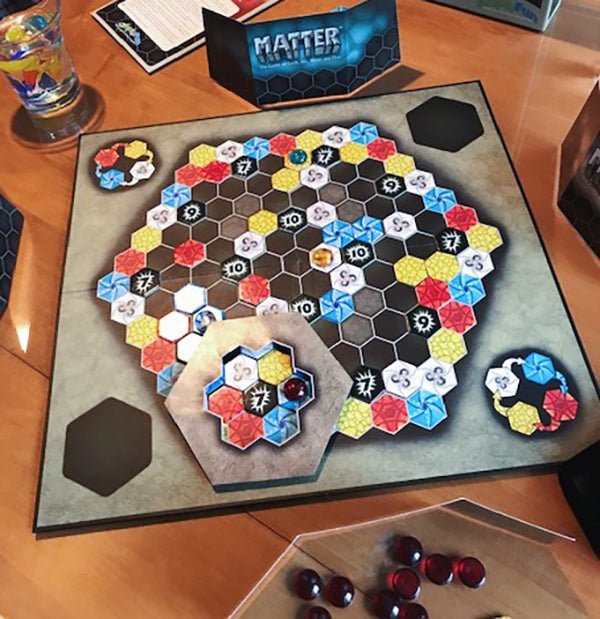
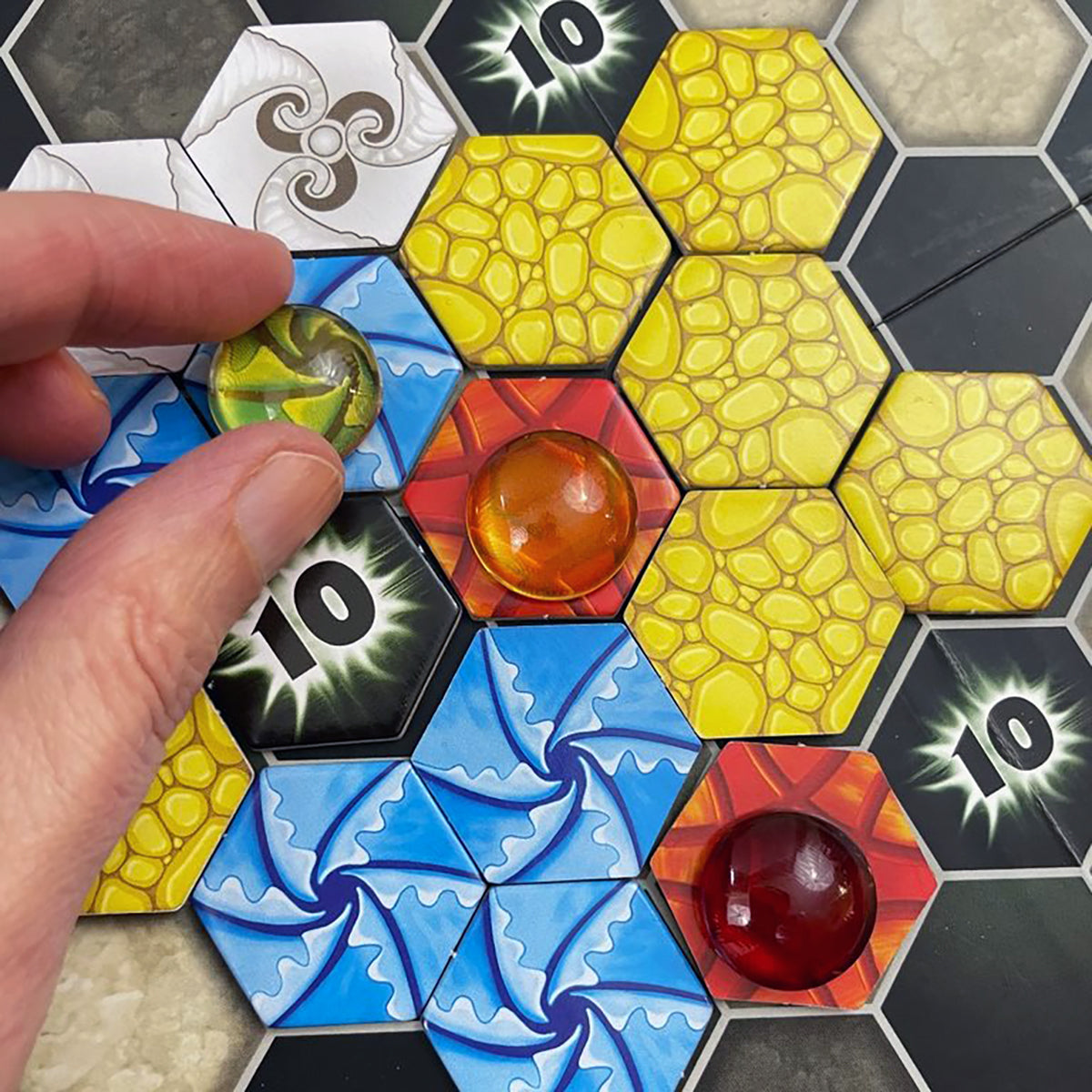
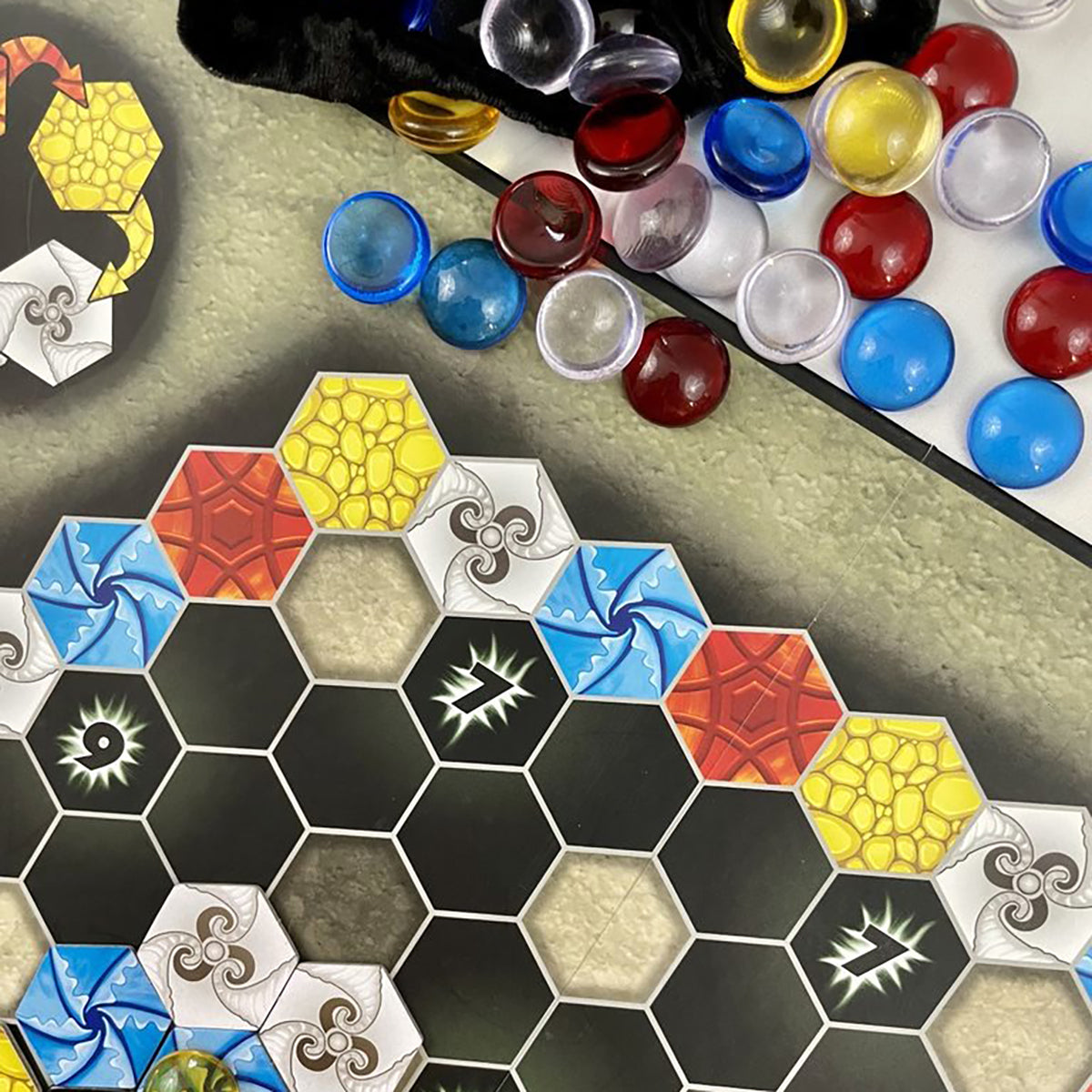
Collapsible content
The object in Matter is to gain control of the numbered hex spaces on the game board. This strategy game plays equally well for 2-4 players, ages 10 and up.
The game consists of a board with many spaces preloaded with elements. Also 92 element tiles, 14 numbered matter tiles and 4 sets of these clear beads which are called elementals. There are also cloth bags for holding the tiles and beads and 4 player screens so everyone can work on their strategy privately.
Matter teaches situational utility. A water tile is a poor choice in a space surrounded by evaporating air. It’s far more useful when combined with other water tiles. Best of all, it could also interfere with someone else’s fire elemental. Water douses fire! This is the balance of compensating controls. There is no “super element” that is the right tool in all situations - every piece is useful in different ways. Matter features moments of deep thought and planning for those who enjoy a strategic game like chess.
Here’s how to play. Place all the numbered tiles on their corresponding spaces. Draw random element tiles from the bag and use them to fill all the grey hexes. You can create a longer and more strategic game by only filling the light hexes, but we recommend you play the basic game your first time.
Each player receives the elemental stones of one color, a player screen, and 4 element tiles drawn from the bag.
Let’s talk about scoring first. Most of the points in Matter are achieved by winning the numbered tiles. As a basic example, you would simply outnumber the other players who are also trying to surround this number. White has outflanked every other color and wins this numbered tile worth 9 points.
However, in Matter, the strength of your elementals is more important than how many you place. Always consider the ring of 6 hexes that surround your elemental to calculate its strength. This earth elemental is bordered by two more earth tiles, so its strength is 3. The water elemental only has 1 water tile supporting it, so it’s strength is 2. The earth elemental is currently winning this numbered tile: 3 strength vs 2 strength.
But remember that elemental strength is also impacted by its counter elements. The earth elemental is decreased by 2 due to the surrounding fire tiles. The water elemental is actually winning here: with 2 strength vs 1 strength.
The strengths of your elementals are added together, so it’s possible for 2 weak elementals to outnumber 1 stronger one.
Ok. Now that you understand how to calculate strength - here’s how to play. The player who woke up earliest today starts the game. On each turn, you must play one of your element tiles,
and then you may place one of your elementals on the tile you just played. You may never add elementals to any other spaces on the board, nor move them, so choose carefully!
End your turn by drawing a new tile from the bag.
The game ends when all hex spaces are filled with element tiles. Score the numbered tiles by determining who has the most influence on each. Whenever there is a tie, divide the points - rounding down. Also, each elemental not put into play is worth three points.
Matter can seem overwhelming at first glance. It’s really important to understand scoring before you start playing. With beginners - you can even try a simplified game where you don’t involve the counter elements.
Another nice thing about Matter is it plays well in teams. Two players play as a team against the combined forces of the other two. Instead of calculating each player’s position separately, combine their elemental strength when determining who wins the numbered tiles. Otherwise, the game is played the same. Have fun with it!


Core Standard*: Math
Math
- Operations and Algebraic Thinking
- Generate and analyze patterns. Grade Level 4th
- Analyze patterns and relationships. Grade Level 5th
- Geometry
- Reason with shapes and their attributes. Grade Level 3rd
- Mathematical Practice
- Make sense of problems and persevere in solving them. Grade Levels 3rd, 4th, 5th
- Look for and make use of structure. Grade Levels 3rd, 4th, 5th


Explore
What Does Child Do To Use Skill In The Game?
Players explore the game board, looking at patterns, openings and options for placing Elementals and Elemental Tiles; as well as where opponents have placed Elementals.
How Parents Can Assist Learning
Remind children to look at the board carefully during play, making sure to identify where the Elementals are, which Matter Tiles are close to being encircled, and open spots where they can place their Elemental Tiles for maximum effect. This will discourage impulsive actions.
Learning Implications and Educator Support
Playing Matter helps children develop spatial reasoning skills, situational analysis, risk assessment and perspective changing.Remind children to look at the board carefully during play, making sure to identify where the Elementals are, which Matter Tiles are close to being encircled, and open spots where they can place their Elemental Tiles for maximum effect. This will discourage impulsive actions.
Determine
What Does Child Do To Use Skill In The Game?
Players need to determine the best location to place a tile, considering the power relationship of adjacent Elemental Tiles. They also need to determine when to use their Elementals.
How Parents Can Assist Learning
Parents can help children look at the power relationships of Elemental Tiles on the board, who has the most power around a Matter Tile and openings for where they can play their Elemental Tiles and Elementals on their turn.
Learning Implications and Educator Support
Matter involves examining the board and creating mental models of the consequences of placing tiles and Elements. When first learning to play, players will think about consequences of the immediate move. As they become more proficient, children will think about multiple moves ahead in order to evaluate what piece would be best to move on their turn.
In addition to determining where to place a tile on a turn, children need to determine what type of strategic approach, offensive or defensive, to use during the game.Educators can help children look at the power relationships of Elemental Tiles on the board, who has the most power around a Matter Tile and openings for where they can play their Elemental Tiles and Elementals on their turn.
Compare
What Does Child Do To Use Skill In The Game?
Players need to compare the locations and the power relationships of Elemental Tiles around those locations.
How Parents Can Assist Learning
Ask children to describe aloud the power points of different Elemental Tile combinations surrounding Matter Tiles in order help them identify best options for placing an Elemental. Ask specific questions such as, "Look at these two options. Which would be a better place to put your elemental tile?"
Learning Implications and Educator Support
Comparing in Matter helps children learn situational analysis because they need to consider and compare the consequences of playing a tile and, possibly, an Element on each turn.To help children, have them describe aloud the power points of different Elemental Tile combinations surrounding Matter Tiles in order help them identify best options for placing an Elemental. Ask specific questions such as, "Look at these two options. Which would be a better place to put your elemental tile?" Verbalizing is a good technique for strengthening the child's analytical abilities and problem-solving.
Remember
What Does Child Do To Use Skill In The Game?
Players need to remember which Element defeats which.
How Parents Can Assist Learning
If children have difficulty remembering, remind them to look at the corners of the board that visually show which Element defeats which.
Learning Implications and Educator Support
If children have difficulty remembering, remind them to look at the corners of the board that visually show which Element defeats which.
Predict
What Does Child Do To Use Skill In The Game?
Players predict where they think opponents will play Elemental Tiles.
How Parents Can Assist Learning
Playing Matter helps children develop spatial reasoning skills, situational analysis, risk assessment and perspective changing. Using an Elemental indicates that a player is considering taking the Matter tile nearby. Point this out to younger players to help them predict what their opponent(s) might do next, which can help them strategize their next move.
Learning Implications and Educator Support
Playing Matter helps children develop spatial reasoning skills, situational analysis, risk assessment and perspective changing, all skills that can be used to make more accurate predictions of opponents' moves. Additionally, making predictions requires analysis, observation, empathy and interpretation.
Educators can encourage children to discuss their options and to declare whether they want to make an offensive (ex: place a tile and Elemental in such a way as to win a number tile) or defensive (ex: placing a tile in such as way as to thwart an opponent's attempt to capture a number tile) move prior to placing a tile and/or Elemental on the board.
Using an Elemental indicates that a player is considering taking the Matter tile nearby. Point this out to younger players to help them predict what their opponent(s) might do next, which can help them strategize their next move.
Plan
What Does Child Do To Use Skill In The Game?
Planning is a key skill used and developed in this game. Players on constantly examining the board and the moves of opponents in order to decide on their next move and subsequent moves.
How Parents Can Assist Learning
To be successful in this game requires thinking about consequences beyond a player's immediate move. This type of long-term, sequential thinking is important beyond the game for activities such as building forts, making art, successfully completing schoolwork on time and launching a new business from a lemonade stand to a company later on in life.
Learning Implications and Educator Support
Planning is an important skill for developing strategic thinking, persistence and reaching a goal. Encourage the children to discuss the goal for the game and how they might play their pieces to reach the goal.
Additionally, to be successful in this game requires thinking about consequences beyond a player's immediate move. This type of long-term, sequential thinking is important beyond the game for activities such as building forts, making art, successfully completing schoolwork on time and launching a new business from a lemonade stand to a company later on in life
Experiment
What Does Child Do To Use Skill In The Game?
Players can experiment with different approaches to winning the game, adopting offensive strategies or defensive strategies.
How Parents Can Assist Learning
Matter is good for experimenting with strategy and tactics. Discuss different strategies prior to starting the game and encourage the child to select one. Play the game and discuss. Then, play again with the child trying a different strategy. Discuss again and compare the advantages and disadvantages.
Learning Implications and Educator Support
Matter is good for experimenting with strategy and tactics. Discuss different strategies prior to starting the game and encourage the child to select one. Play the game and discuss. Then, play again with the child trying a different strategy. Discuss again and compare the advantages and disadvantages.
Practice
What Does Child Do To Use Skill In The Game?
Once players understand the rules and the functions of the Elemental tiles, practice will result in players' increasing strategic capabilities.
How Parents Can Assist Learning
When learning this game, play several rounds collaboratively without the Player Screens. Talk about different moves and the consequences of each. Give children a couple of options for placing an Elemental Tile so they can compare consequences of a possible move, allowing them to chose the ultimate placement of a Tile or use of an Elemental.
Learning Implications and Educator Support
Matter has several implicit levels of mastery. Therefore, the more children play the more capable they will be in developing and executing increasingly sophisticated strategies. Also, as they become proficient, they will be able to teach others. Teaching others demonstrates mastery, the final stage of learning, and is wonderful for building self-esteem, confidence and intrinsic motivation.
Solve
What Does Child Do To Use Skill In The Game?
This game involves many intermediate solutions (e.g. capturing Matter tiles) and a long term solution (having the most points at the end of the game). As the game progresses, players may change strategies, such as shifting from offensive efforts to obtain Matter Tiles to defensive effort to stop others from getting Matter Tiles or preserving Elementals.
How Parents Can Assist Learning
As the game is being learned, children may place Elementals or Elemental Tiles in non-strategic ways. If you see this, ask the child to explain their thinking and discuss what they might do differently next time. After children have mastered the rules and functions of the pieces, they learn new information constantly during game play. This information directly effects how children strategize an approach for placing Elemental Tiles and Elementals and ultimately solve the game. The ability to shift strategies based on new information can help children cope with the stresses of change in other areas of their life.
Learning Implications and Educator Support
Matter involves uses of visual spatial problem solving, directionality and if/then problem solving. After children have mastered the rules and functions of the pieces, they learn new information constantly during game play. This information directly effects how children strategize an approach for placing Elemental Tiles and Elementals and ultimately solve the game.
Review
What Does Child Do To Use Skill In The Game?
Children may review if encouraged. See How Parents Can Assist Learning.
How Parents Can Assist Learning
This game involves uses of visual spatial problem solving, directionality and if/then problem solving. As the game is being learned, children may place Elementals or Elemental Tiles in non-strategic ways. If adults see this, ask the child to explain their thinking and discuss what they might do differently next time.
Learning Implications and Educator Support
This game involves uses of visual spatial problem solving, directionality and if/then problem solving. As the game is being learned, children may place Elementals or Elemental Tiles in non-strategic ways. If adults see this, ask the child to explain their thinking and discuss what they might do differently next time.
Demonstrate
What Does Child Do To Use Skill In The Game?
Children may demonstrate if encouraged. See How Parents Can Assist Learning.
How Parents Can Assist Learning
When children win Elements or the game, encourage them to share their thinking and which moves were especially helpful in winning.
Learning Implications and Educator Support
When children win Elements or the game, encourage them to share their thinking and which moves were especially helpful in winning.Demonstrating knowledge, skills and abilities is an important step in the learning process because it 1) allows a child to show his or her mastery, i.e. that s/he has learned something thoroughly enough to share and even teach it to another, and 2) is the beginning of the next level of learning.
*Data compiled from CCSSI ELA Standards, WA Science Standards, and Washington Social Studies Standards


Cognitive
Suggestions for How to Modify Play Experience
Children with cognitive delays may have difficulty keeping track of 4 elements. To simplify the game for them, reduce the number of types of tiles players get and eliminate the Elementals. For a two-player game, give one player the fire and wind tiles and the other player the earth and water tiles. When a number is surrounded, the player with the most of their element tiles around the number wins the number. For a four-player game, each player gets all the tiles of one Element.
Play the game without the Elementals. The goal of this variation is to earn a number tile by surrounding it. The person who places the last tile around the number wins the number tile. The only rule is that you many not place a tile down in a spot that is adjacent to an Elemental tile that defeats it. For example, you cannot place a fire tile next to a water tile.
Play the game initially as a collaborative effort of all players. The game is played the same way, except each turn is discussed as to whether the move is a good one. When a numbered matter tile is removed it goes into the group "won" pile. Playing without one winner removes the competitive element and allows children to learn different strategies. Later when the game is played independently, children will then understand the goals and strategies needed.
Communication
Suggestions for How to Modify Play Experience
The game requires communication, as players count their points to determine who wins the numbered matter tile. If language processing is a concern for the child, the adult can help organize the discussion by pointing to each tile in turn and waiting for the child to respond. In this way, the adult can assist if the child is having difficulty producing the needed language.
Children with language comprehension issues may find the directions difficult to understand. Clarify the rules by demonstrating several versions of how to win a number tile. A visual explanation in addition to verbal will make the rules easier to understand. Encourage the child to demonstrate an example as well. This will enable the adult to see if the rules are understood.
Sensorimotor
Suggestions for How to Modify Play Experience
The tiles in this game will be too difficult to arrange for children with fine motor problems. For this reason the game is not recommended for these children.
Social Emotional/Behavioral
Suggestions for How to Modify Play Experience
Team play is recommended for children with low frustration tolerance and/or attention issues. In a team format, children will be able to help each other think through the options to decide what locations offer the most potential for adding to the score and which tile to play. Encourage players to discuss the justification for their ideas at each turn. This process builds negotiation skills.
If children seem to be placing tile impulsively, the adult should ask the child to explain their rationale. Asking the child to justify their decision makes the child pause to think. If there is no logical reason for the placement, take the tile and show the child two other spots the tile could be placed. Ask the child which would be better. Giving choices helps the child narrow down the options, but also retain control.
Play the game initially as a collaborative effort of all players. The game is played the same way, except each turn is discussed as to whether the move is a good one. When a numbered matter tile is removed it goes into the group "won" pile. Playing without one winner removes the competitive element and allows children to learn different strategies. Later when the game is played independently, children will then understand the goals and strategies needed. This approach will help children who are insecure gain needed confidence.
Vision
Suggestions for How to Modify Play Experience
The game is visually complex and, therefore, is not recommended for children with low vision.
Hearing
Suggestions for How to Modify Play Experience
Use sign language with children with hearing impairments. The only signs needed are for earth, air, fire, and water, and the numbers. If hearing impaired children do not use sign language, choose agreed upon gestures for each of the words and fingers for counting.
*Data compiled from CCSSI ELA Standards, WA Science Standards, and Washington Social Studies Standards


Autism Special Considerations
Appears to ignore other's communication and/or has difficulty giving eye contact to a communication partner
Is This Game Appropriate for Child with Characteristic? Yes
Can Child with Characteristic Play Game w/o Modification? Yes
Strategies for Developing Compensatory Skills:
Sit at an angle to the child, so direct eye contact is not needed. Look at the game instead of each other.
Has difficulty understanding complex verbal directions
Is This Game Appropriate for Child with Characteristic? No
Can Child with Characteristic Play Game w/o Modification? No
Strategies for Developing Compensatory Skills:
Matter is not an appropriate game for children who have difficulty understanding complex directions. Children need to move be able to move all markers both offensively and defensively. In addition, the directions are complex for what to do in different circumstances.
Uses vocabulary inaccurately or demonstrates echolalia (repeating another's speech)
Is This Game Appropriate for Child with Characteristic? Yes
Can Child with Characteristic Play Game w/o Modification? Yes
Strategies for Developing Compensatory Skills:
Respond to immediate echolalia (repeating what was just said) by rephrasing the child's response into a correct format, so the child can hear and repeat that phrase. For example, assume you are playing with a child named Andy and you say, "Your turn," and Andy repeats, "Your turn." You can say, "It's Andy's turn. You say, my turn." This allows the child to hear and repeat the correct response. Eventually, the child will pick up the pattern of response.
Delayed echolalia (repetition of previously heard comments) may have a hidden meaning or association. Look for connection in the phrase used to the current situation. For example, the child says, "After these messages we'll be right back!" Think what the repeated phrase is associated with for the child. Try to interpret what is meant and rephrase it for the child. For example, you might respond by saying, "It sounds like you want a break for a few minutes. Is that what you mean? You can tell me, 'I need a break.'"
Gets stuck repeating a verbal topic or physical actions and/or has difficulty attending to others' actions or topic.
Is This Game Appropriate for Child with Characteristic? No
Can Child with Characteristic Play Game w/o Modification? No
Strategies for Developing Compensatory Skills:
Children need to pay attention to other player's intentions and actions, as there are both offensive and defensive components to play. For this reason Matter is not recommended for children with this concern.
Has difficulty producing speech/communication
Is This Game Appropriate for Child with Characteristic? Yes
Can Child with Characteristic Play Game w/o Modification? Yes
Strategies for Developing Compensatory Skills:
Use augmentative communication, such as picture cards. For example, a picture of person pointing to another person means "your turn." Communication during and after a play is not required.
Has difficulty sequencing multi-step actions and/or doing complex abstract tasks
Is This Game Appropriate for Child with Characteristic? No
Can Child with Characteristic Play Game w/o Modification? No
Strategies for Developing Compensatory Skills:
Matter is not appropriate for children who have difficulty comprehending complex abstract tasks.
Demonstrates difficulty initiating and maintaining social interactions
Is This Game Appropriate for Child with Characteristic? Yes
Can Child with Characteristic Play Game w/o Modification? Yes
Strategies for Developing Compensatory Skills:
Develop a social story to be read at the start of a game. A social story is a short booklet that illustrates how a child can use positive social skills. It includes two to five descriptive statements and a directive statement. For example: "When I watch others, I will know when it is my turn. Others like me when I take turns. I will watch what others do with their pieces and listen to what they say. Others like it when I talk about the game." Add photos or drawings of the child doing the actions described in the story.
Role play social situations and reinforce appropriate words and actions. For example, role play commenting on another player's turn. For instance, "Paul played an earth tile. What is needed to beat earth?"
Use video feedback of positive social behaviors. Video of actual play enables children to see what they or others did. Appropriate actions and interactions can then be discussed.
Acts out or demonstrates avoidance behaviors when frustrated, overwhelmed, or needs more sensory input.
Is This Game Appropriate for Child with Characteristic? Yes
Can Child with Characteristic Play Game w/o Modification? No
Strategies for Developing Compensatory Skills:
Reduce extraneous noise or allow the child to wear head phones or ear plugs if loud sounds cause anxiety.
A weighted vest worn during the game may provide additional pressure input and thus reduce fidgeting due to sensory needs. Pressure can be calming when used for no more than 20 minutes at a time.
Practice a phrase to ask for help and role play situations in the game where it is needed.
Provide techniques for self-calming, such as holding a special toy.
Allow time for movement. For example, a child who needs to move frequently can be given an opportunity to 'celebrate' their turn by running around the table or jumping up and down 10 times.
Has short attention span for non-preferred activities
Is This Game Appropriate for Child with Characteristic? No
Can Child with Characteristic Play Game w/o Modification? No
Strategies for Developing Compensatory Skills:
Not recommended for children with a short attention span.
Needs sameness or consistent routines and/or has difficulty with transitions from one activity to another
Is This Game Appropriate for Child with Characteristic? Yes
Can Child with Characteristic Play Game w/o Modification? Yes
Strategies for Developing Compensatory Skills:
Play games at the same time every day, so the child anticipates the game routine.
Change the location of the game, so the child may play in different rooms, at the table, or on the floor. This will build tolerance for variation.
Prepare the child ahead time for the introduction of a new game. Talk about aspects that will be motivating for the child, and let them explore the parts of the game before setting out the whole game.
Provide a structure for placement of game pieces that can be the same each time the game is played. For example, have a specific location for where the board goes, the pieces, etc.
Provide choices for how the child can be involved in set up or clean up. For example, you might ask, "Do you want to pass out the dice and cups or set up the board?"
Provide choices for how the child can be involved in set up or clean up. For example, you might ask, "Do you want to set up the board or hand out the pieces?"
Involve the child verbally and with actions for the transition to the game table or at the end of game play. For example, you might say, "Here's a water tile, what does it do?"
Has difficulty understanding others' feelings, intentions, and the reasons for others' actions.
Is This Game Appropriate for Child with Characteristic? No
Can Child with Characteristic Play Game w/o Modification? No
Strategies for Developing Compensatory Skills:
Matter is not recommended for children who have difficulty understanding others intentions and reasoning. Children need to anticipate other players' options and respond to plays both offensively and defensively.
*Data compiled from CCSSI ELA Standards, WA Science Standards, and Washington Social Studies Standards


Extra Ways to Play the Game
For tiles that are adjacent to the activated Elements, you can add points for any tiles that the activated Element beats. This allows players to count more points, rather than just deduct points for Elements that defeat the activated Element, such as Water defeating Fire.
Materials Needed
No additional materials needed.
Developmental Benefits
This modification increases the players' potential for point combinations and adds another aspect of strategy.
Extra Ways to Play the Game
Add points for any Elements that are connected to the activated Element as long as they are connected to the same as the activated Element. For example, if an activated Fire Element has three additional Fire Elements connected to it in a straight line, you would get 4 points. This expansion enables players to use additional strategies to increase points around the numbered matter tile.
Materials Needed
No additional materials needed.
Developmental Benefits
This modification increases the players' potential for point combinations, and adds another aspect of strategy.
*Data compiled from CCSSI ELA Standards, WA Science Standards, and Washington Social Studies Standards






